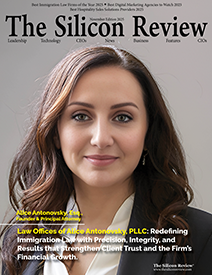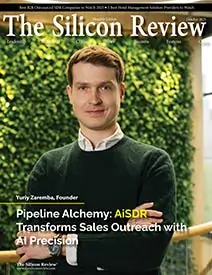>>
Industry>>
EdTech>>
Collaborative Word Cloud Activ...Collaborative Word Cloud Activity: Fostering Creativity and Engagement
The Silicon Review
04 March, 2025
In today's digital age, fostering collaboration and creativity in educational and professional settings is more crucial than ever. One engaging and interactive way to promote these values is through a collaborative word cloud activity. This simple yet powerful exercise encourages participants to share their thoughts, visualize ideas, and work together towards a common goal. By combining technology with teamwork, a collaborative word cloud activity fosters creativity, engagement, and meaningful discussions.
This article explores the concept of a collaborative word cloud activity, how it works, its benefits, and practical tips for implementation. Whether you are an educator, team leader, or event organizer, integrating this activity into your sessions can transform the way participants interact and express their ideas.
What is a Collaborative Word Cloud Activity?
A collaborative word cloud activity involves participants contributing words or phrases related to a central theme or question. These responses are then aggregated and displayed visually in a word cloud format. Words that are mentioned more frequently appear larger, while less common words are smaller. This real-time visualization provides an immediate snapshot of collective thoughts and ideas.
The activity can be conducted in person or virtually using various online tools and platforms. Participants can submit their responses anonymously, allowing for candid input and a diverse range of perspectives. Whether the topic is lighthearted or serious, the collaborative word cloud provides an inclusive and dynamic way to gather and reflect on group input.
What are the advantages of a collaborative word cloud
A collaborative word cloud is a powerful tool for fostering group participation and idea sharing. It allows multiple users to contribute words in real-time, creating a visual representation of collective thoughts. This method encourages inclusivity, ensuring every voice is heard. It also aids in brainstorming by highlighting common themes, as frequently mentioned words appear larger. Collaborative word clouds are ideal for meetings, classrooms, and workshops, enhancing communication and revealing trends quickly. They promote creativity, streamline discussions, and provide a dynamic way to visualize diverse perspectives, making collaboration more interactive and productive.
Create Your Collaborative Word Cloud with Wooclap
In today’s digital age, fostering active participation during presentations and lectures is crucial. Wooclap, an innovative audience engagement platform, offers a dynamic solution through its collaborative word cloud feature. This tool allows you to gather input from participants in real time, transforming their responses into a visually compelling word cloud.
Why Use Wooclap for Word Clouds?
Wooclap’s word cloud feature is perfect for educators, corporate trainers, and event organizers who want to make their sessions more interactive. By allowing participants to submit words or phrases via their devices, Wooclap instantly compiles the responses and displays the most frequently mentioned terms prominently. This visual representation helps highlight key themes and insights while fostering a sense of collective input.
The platform is user-friendly and accessible on any device with an internet connection. This ensures that everyone, whether in a physical room or attending remotely, can participate seamlessly. Additionally, Wooclap offers customizable settings, allowing you to filter inappropriate responses, set response limits, and choose display preferences to align with your event’s objectives.
Benefits of a Collaborative Word Cloud Activity
Implementing a collaborative word cloud activity offers numerous advantages across different settings. Here are some key benefits:
1. Encourages Participation
Word cloud activities lower the barrier to entry for participation. Unlike traditional discussions where more vocal individuals may dominate the conversation, this activity allows everyone to contribute equally. Even those who are shy or hesitant to speak in public can share their thoughts comfortably.
2. Promotes Creativity and Idea Generation
By encouraging participants to brainstorm and submit words related to a theme, the activity sparks creativity. The visual representation of ideas allows for new connections and insights to emerge. Seeing others' contributions can also inspire participants to think more expansively and build on shared ideas.
3. Enhances Collaboration and Team Building
When teams collaborate on a shared word cloud, it fosters a sense of unity and collective ownership. This activity can serve as an icebreaker, a team-building exercise, or a tool for collaborative problem-solving. It creates a shared space where all voices are heard and valued.
4. Provides Real-Time Feedback and Insights
Word clouds offer instant visual feedback, making them a valuable tool for gauging understanding and sentiment. Facilitators can use the word cloud to identify common themes, address misconceptions, or guide further discussion. This real-time feedback loop enhances engagement and allows for adaptive learning.
5. Adaptable to Various Contexts
The collaborative word cloud activity is highly versatile and can be adapted to suit various contexts. It works well in classrooms, corporate meetings, workshops, conferences, and even social events. Whether used for brainstorming, reflection, or data collection, the format can be customized to meet specific objectives.
How to Implement a Collaborative Word Cloud Activity
Integrating a collaborative word cloud activity into your sessions is simple and requires minimal resources. Here is a step-by-step guide to ensure a successful and engaging experience:
1. Define Your Objective
Start by clarifying the purpose of the activity. Are you aiming to gather opinions, spark creativity, or gauge understanding? Clear objectives will guide your question framing and ensure the activity aligns with your goals.
2. Choose a Word Cloud Tool
Select a reliable word cloud generator that supports real-time collaboration. Popular tools include Mentimeter, WordArt, Poll Everywhere, and Slido. Many of these platforms are user-friendly and offer customization options to enhance the participant experience.
3. Frame Your Question or Prompt
Craft a clear and engaging question or prompt. Open-ended questions work best for word cloud activities. Examples include:
- "What one word describes your experience today?"
Tailor your prompt to suit the context and desired outcomes.
4. Facilitate Participation
Provide participants with easy access to the word cloud tool via a QR code, link, or embedded widget. Encourage everyone to submit their responses and clarify whether contributions will be anonymous. Set a time limit to keep the activity focused and dynamic.
5. Analyze and Discuss the Word Cloud
Once responses are collected, display the word cloud for all participants to view. Highlight prominent themes and ask participants to interpret the results. Use the visualization as a springboard for deeper discussion and reflection.
6. Follow Up and Reflect
Capture the word cloud as a visual artifact to share after the session. This can serve as a summary of key ideas and a reference point for future conversations. Reflect on the activity's outcomes and gather participant feedback to refine your approach.
Tips for a Successful Collaborative Word Cloud Activity
To maximize the impact of your collaborative word cloud activity, consider the following best practices:
- Set Clear Guidelines: Ensure participants understand the activity's purpose and submission process.
- Encourage Diverse Input: Invite a wide range of voices by emphasizing inclusivity and anonymity.
- Monitor and Moderate: Be prepared to filter inappropriate responses if necessary.
- Keep it Interactive: Engage participants by incorporating live discussions and follow-up questions.
- Celebrate Contributions: Acknowledge and appreciate the input from all participants.
Real-World Applications of Collaborative Word Clouds
1. Education
Teachers can use word clouds to assess prior knowledge, facilitate classroom discussions, or summarize key concepts. It offers a visual and interactive way to engage students and foster a collaborative learning environment.
2. Corporate Training and Meetings
In professional settings, word clouds can be used to gather employee feedback, spark brainstorming sessions, or evaluate training effectiveness. This activity promotes transparency and collective problem-solving.
3. Conferences and Workshops
Word clouds can capture audience insights during keynote speeches, panels, or breakout sessions. They provide a real-time pulse check and foster interaction among attendees.
4. Community Events
For community groups or social events, word clouds can gather collective opinions on local issues, highlight shared values, or simply capture fun and engaging moments.
Conclusion
A collaborative word cloud activity is a powerful tool for fostering creativity, engagement, and collaboration. Its versatility makes it suitable for a variety of contexts, from classrooms to corporate boardrooms. By providing a platform for all voices to be heard and visualizing collective input, this activity enhances communication and promotes a sense of shared purpose.
Whether you're an educator, team leader, or facilitator, incorporating collaborative word clouds into your toolkit can elevate your sessions and create more meaningful interactions. With the right planning and tools, you can transform ordinary discussions into dynamic, collaborative experiences that leave a lasting impression.


 (1)_2025-10-21_13-35-14.webp)

_2025-10-02_10-21-48.webp)

